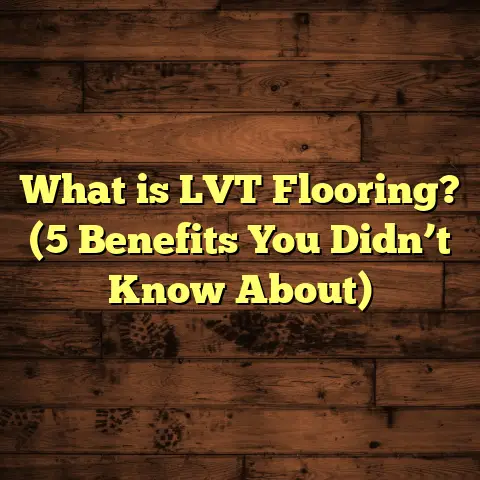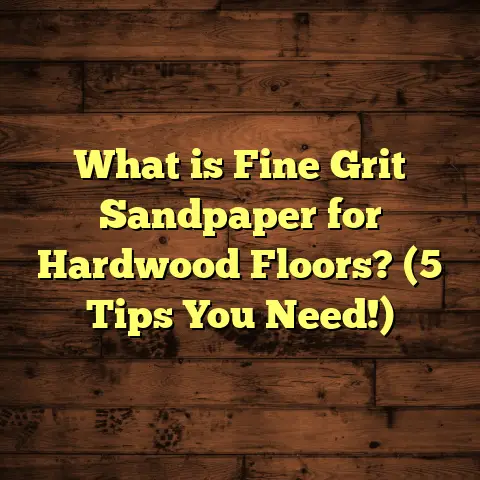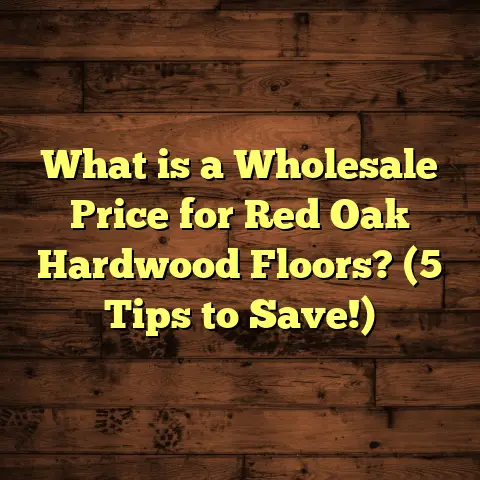What is Better for Basement Flooring: Laminate or Vinyl? (5 Key Differences!)
I remember the day I was called to advise a family renovating their basement. The big question on their minds: laminate or vinyl flooring? Choosing the right floor for a basement isn’t just a matter of picking something that looks good. It’s about durability, comfort, long-term maintenance, and how well it handles moisture. I’ve seen so many basements ruined by poor flooring choices that I want to share everything I know about these two popular options.
If you’re wondering what works best for your space — laminate or vinyl — stick with me. I’ll walk you through everything from how they handle moisture, to installation tricks, and even how much you can expect to spend. Let’s get into it.
What Is Basement Flooring and Why Does It Matter?
Basement flooring refers to the materials you use to cover the floor in your basement — a space usually below ground level. Unlike other rooms, basements face unique challenges:
- Moisture and humidity: Basements often have higher moisture levels due to being partially or fully underground.
- Temperature fluctuations: Basements tend to be cooler and can be drafty.
- Traffic and use: Many basements serve as playrooms, gyms, home theaters, or workshops.
Because of this, the flooring must resist moisture damage, provide comfort underfoot, and look good even in less-than-ideal conditions.
When I first started working in home renovation, I didn’t realize how many homeowners struggled with basement floors that warped, cracked, or got moldy fast. The right flooring can turn a damp, dark basement into a warm living area that adds value and enjoyment to your home.
A Closer Look at Laminate vs. Vinyl Flooring
Before diving into their differences, it helps to understand what laminate and vinyl floors really are.
What Is Laminate Flooring?
Laminate flooring is a multi-layer synthetic product designed to mimic real wood or stone. It usually has:
- A fiberboard core (pressure-molded wood particles)
- A photographic layer that provides the visual design (wood grain, stone texture)
- A clear protective wear layer on top
The layers are fused together using high heat and pressure. The surface is tough enough to resist scratches and dents but vulnerable if exposed to water for too long.
What Is Vinyl Flooring?
Vinyl flooring is made primarily from polyvinyl chloride (PVC) and other compounds. It can come in several forms:
- Sheet vinyl: Large continuous sheets glued down
- Vinyl tiles: Individual tiles glued or loose-laid
- Luxury vinyl planks (LVP): Click-lock planks resembling real hardwood
Vinyl is naturally water-resistant since it’s plastic-based. Its surface layers also resist stains and scratches.
1. Moisture Resistance: The Basement’s Biggest Challenge
One of the first things I ask homeowners is whether their basement has had water problems before. This question alone can steer the entire project.
Vinyl flooring shines when it comes to moisture resistance. Because it’s waterproof by nature, spills, leaks, or even floods won’t ruin it. The seams between vinyl sheets or planks are sealed tightly, preventing water infiltration into the subfloor.
Laminate, however, struggles with water exposure. The fiberboard core absorbs moisture quickly, causing swelling, warping, and eventual breakdown.
My Experience on Moisture Failures
I recall a client who installed affordable laminate flooring in their basement without addressing a minor leak near a window well. After heavy rains, they noticed bubbling and warping in the floorboards within weeks. They ended up replacing the entire floor with luxury vinyl plank — a costly lesson on the importance of moisture resistance.
Research Backing This Up
A report by the Flooring Industry Manufacturers Association found that laminate floors exposed to over 12 hours of standing water can swell by up to 25%, while vinyl floors remained intact under similar conditions.
If your basement is prone to moisture — even just from humidity — vinyl is the safer bet.
2. Installation Ease: DIY-Friendly or Professional Job?
Installing basement flooring can be stressful if you’re new to it. I’ve worked with many homeowners who want to save money by doing it themselves but worry about complexity.
Laminate Installation
Laminate boards almost always use a floating click-lock system. This means:
- No glue or nails needed
- Boards snap together like puzzle pieces
- Floor “floats” above the subfloor with an underlayment beneath for cushioning and moisture barrier
This system makes laminate very popular among DIYers. You can lay it over concrete as long as it’s smooth and dry.
Vinyl Installation Options
Vinyl offers more variety:
- Sheet vinyl: Usually requires professional cutting and glue-down installation for a seamless finish.
- Vinyl tiles: Can be glued down or sometimes peel-and-stick for easier DIY.
- Luxury vinyl planks (LVP): Often use click-lock systems similar to laminate — great for DIY projects.
Personal Anecdote
One homeowner was nervous about installing a floor themselves but loved the idea of LVP because it looked like wood and was easy to snap together. They completed their basement floor over a weekend and were thrilled with the results.
3. Appearance and Style: Making Your Basement Feel Like Home
You probably want your basement flooring to look good — not just functional.
Laminate’s Visual Appeal
Laminate flooring excels at mimicking hardwood down to fine details like knots and grain texture. It captures the warmth of wood at a fraction of the cost of real hardwood. You can find laminate that looks like oak, maple, cherry, or even exotic woods.
Vinyl’s Versatility
Vinyl has caught up fast in appearance. Luxury vinyl planks offer realistic wood textures with embossed surfaces that feel smooth or rough like real wood grain.
Beyond wood looks, vinyl shines in mimicking stone, ceramic tile, concrete, or even intricate patterns like mosaic tiles — all without the coldness or fragility of real tile.
Story from My Projects
I once helped a client who wanted a rustic cabin feel in their basement rec room. We chose laminate with deep wood grain and warm tones. The look was so convincing that guests thought it was real hardwood until they saw the price tag!
Another family who wanted easy cleanup picked vinyl tile with a stone pattern for their basement kitchenette — the waterproof surface was perfect for spills.
4. Durability Over Time: How Long Will Your Floor Last?
Basement floors get heavy use — kids playing, pets running around, exercise equipment — so durability matters.
Laminate’s Strengths and Weaknesses
Laminate resists scratches well thanks to its tough top layer. However:
- Vulnerable to water damage
- Can crack if heavy objects are dropped
- Susceptible to wear in high-traffic zones over time
Vinyl’s Durability Edge
Vinyl flooring holds up better under:
- Moisture exposure
- Heavy foot traffic
- Impact from dropped items
Luxury vinyl planks often come with wear layers rated from 6 mils (moderate use) up to 20 mils (commercial grade). The thicker the wear layer, the longer your floor lasts.
Data from Industry Tests
Independent lab tests show luxury vinyl flooring with 12-mil wear layers can withstand over 15 years of moderate residential use with proper care compared to laminate’s average 10 years before signs of wear appear.
5. Cost Breakdown: What Will You Pay?
Budgeting is always part of any home project.
Laminate Pricing
Laminate flooring costs vary based on quality:
- Basic laminate: $1–$2 per sq ft
- Mid-range laminate: $2–$4 per sq ft
- High-end laminate (better visuals/durability): $4–$5 per sq ft
Installation for laminate click-lock floors typically runs $1–$3 per sq ft if hiring professionals.
Vinyl Pricing
Vinyl ranges widely:
- Sheet vinyl (basic): $0.50–$2 per sq ft
- Vinyl tile (mid-range): $1–$3 per sq ft
- Luxury vinyl plank (higher-end): $3–$7 per sq ft
Professional installation can add $2–$5 per sq ft depending on type.
Total Cost Example
For a 500 sq ft basement:
| Flooring Type | Material Cost | Installation Cost | Total Cost |
|---|---|---|---|
| Basic Laminate | $500 – $1000 | $500 – $1500 | $1000 – $2500 |
| Luxury Vinyl Plank | $1500 – $3500 | $1000 – $2500 | $2500 – $6000 |
If budget is tight but moisture isn’t an issue, laminate offers great value. For better durability and peace of mind against moisture damage, plan to invest more in vinyl.
Installation Tips Specific to Basements
I want to share some practical tips I always follow when installing floors in basements:
Prepare Your Subfloor Thoroughly
Basements often have concrete slabs that can be uneven or cold. Before installing either laminate or vinyl:
- Check for cracks or moisture seeping through
- Use a vapor barrier (plastic sheeting) under laminate
- Consider foam underlayment for insulation and soundproofing
- Ensure subfloor is level; uneven floors cause locking systems not to click properly
Acclimate Flooring Materials
Bring your flooring indoors at least 48 hours before installation so they adjust to basement temperature and humidity levels.
Leave Expansion Gaps
Both laminate and vinyl expand/contract slightly with temperature changes. Leaving gaps around perimeter prevents buckling over time.
Maintenance Advice for Longevity
Keeping your basement floor looking great involves regular care:
For Laminate Floors
- Clean spills immediately to prevent water damage
- Use a slightly damp mop; avoid soaking water
- Avoid abrasive cleaners that damage wear layer
- Use furniture pads to prevent scratches
For Vinyl Floors
- Wipe up spills promptly but vinyl tolerates moisture much better
- Sweep or vacuum regularly
- Clean with mild detergent solutions
- Avoid wax or polish unless manufacturer recommends it
Common Problems and How To Fix Them
Every flooring type has potential issues:
Laminate Problems
Swelling due to moisture: If you catch it early, dry out area thoroughly and replace damaged boards.
Click-lock joints popping: Usually caused by improper installation or uneven subfloor; sometimes reinstallation needed.
Vinyl Problems
Seam separation in sheet vinyl: Often from poor adhesive application; professional repair recommended.
Indentations from heavy furniture: Use protective pads or rearrange heavy items periodically.
Real-Life Case Studies From My Work
Case Study 1: Family Basement Playroom (Vinyl Success)
The Johnsons had a damp basement prone to occasional flooding after storms. They wanted safe flooring for kids’ play area that was easy to clean. We installed luxury vinyl plank with a waterproof core.
After two years of heavy use and several small floods, their floors look as good as day one without any warping or staining.
Case Study 2: Dry Finished Basement Office (Laminate Win)
The Martin family’s basement was dry year-round with excellent ventilation. They wanted an upscale wood look without breaking the bank.
We installed mid-range laminate with oak visuals. The floor feels warm underfoot and has held up well after three years of use without any signs of moisture damage.
Comparing Laminate & Vinyl to Other Basement Flooring Options
Sometimes people ask about carpet or tile for basements:
Carpet: Cozy but traps moisture; leads to mold risks unless basement is perfectly dry and ventilated.
Ceramic/Porcelain Tile: Waterproof and durable but cold and hard; needs special subfloor preparation to avoid cracking.
Engineered Hardwood: Looks great but still sensitive to moisture; expensive installation; not ideal for damp basements.
For most homeowners wanting style + practicality + budget-friendliness — laminate and vinyl remain top choices.
Final Thoughts on Choosing Between Laminate & Vinyl
If you’re still wondering which one makes more sense for your basement, here’s my takeaway based on years of experience:
| Factor | Laminate Flooring | Vinyl Flooring |
|---|---|---|
| Moisture Resistance | Moderate; avoid high humidity areas | Excellent; waterproof options |
| Installation Ease | DIY-friendly click-lock system | Flexible; click-lock & glue options |
| Appearance | Realistic wood textures | Wood + tile + stone looks |
| Durability | Good if kept dry | Superior resistance to water & wear |
| Cost | Lower upfront investment | Slightly higher but less risk |
| Maintenance | Requires quick spill cleanup | Easier care & cleaning |
| Longevity | 10–15 years | 15–20+ years |
If your basement is dry and budget-conscious, laminate can give you a beautiful floor at less cost. But if there’s any chance of moisture or heavy wear, vinyl’s durability pays off in the long run.
Need Help Budgeting Your Basement Flooring?
To help you plan your project budget accurately, I often use FloorTally — an online tool that calculates costs based on local material prices and labor rates. It factors in waste percentage so you order just enough materials without overspending.
Would you like me to generate an estimate using FloorTally for your project? It only takes a few minutes but provides detailed info that saves money down the road by avoiding surprises.
Thanks for sticking with me through all this! If you have questions about specific brands or want advice on subfloor preparation or maintenance tricks, just ask. I’ve been through hundreds of basement installs and love sharing what works best so your floor lasts long and looks fantastic.
Ready to pick your perfect basement floor?





